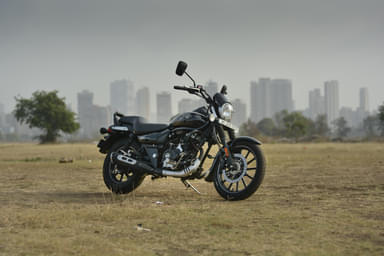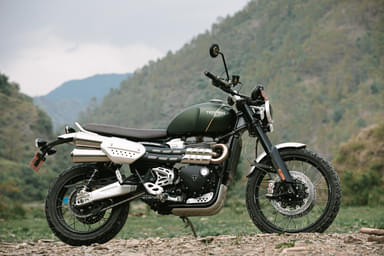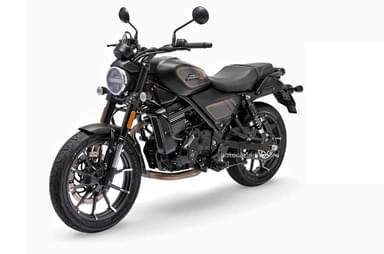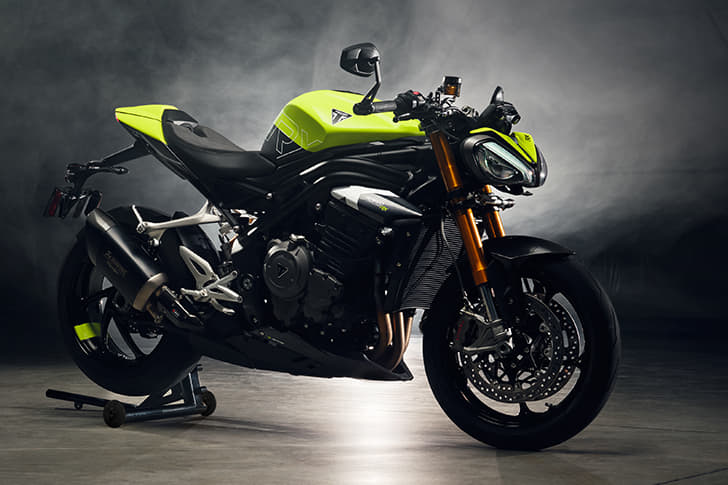
Last Updated on: 06 Oct 2025
Triumph Speed T4
The Triumph Speed T4 blends efficiency and style, offering a mileage of that makes it a reliable option for riders. It was officially launched on Sept. 17, 2024. With just one variant on sale, the Triumph Speed T4 is priced at ₹1.93 lakh ex-showroom, while the on-road price changes depending on the region.
The Speed T4 is available in 3 attractive shades, including Baja Orange, Phantom Black / Pearl Metallic White, Phantom Black / Storm Grey, giving buyers a range of options.
Triumph Speed T4 Features and specifications
Our Rating | Yet to be Reviewed |
Body Type | Bike |
Engine | 398.15 cc |
Fuel Type | Petrol |
Transmission | Manual |
Max Power | 30.6 bhp @ 7000 rpm |
Max Torque | 36 Nm @ 5000 rpm |
Triumph Speed T4 price & variants
The Triumph Speed T4 comes in just one variant and is priced at ₹1.93 lakh (ex-showroom). The Speed T4 on road price will vary depending on RTO, insurance, and other factors.
Triumph Speed T4 expert review
We like
Improved fuel efficiency
Smooth throttle response
We don't like
Brakes lack feedback
Ride quality over bad roads
Triumph Speed T4 reviews

Triumph Speed T4 comparison








































Triumph Speed T4 mileage
The Triumph Speed T4 provides a claimed mileage of , making it practical for city traffic as well as occasional highway rides.
| Fuel type | Displacement | Transmission | Mileage |
|---|---|---|---|
| Petrol | 398.15 cc | Manual | NA |
Triumph Speed T4 news
Triumph Speed T4 Images
A total of 18 images are available for the Triumph Speed T4, covering its design, finish, and key features.
Triumph Speed T4 Colours
Riders can select from 3 available colors for the Triumph Speed T4, such as Baja Orange, Phantom Black / Pearl Metallic White, Phantom Black / Storm Grey.
Trending Questions on Triumph Speed T4 - Answered by Autocar Experts
I am confused between the Royal Enfield Classic 350, Royal Enfield Meteor 350, and Triumph Speed T4. My maximum budget is ₹2.5 to 2.8 lakh. If possible, please suggest some customisation options within this budget. I live in Bhubaneswar, Odisha. Please help.
Hi, I am currently planning to buy a 400cc bike. I have shortlisted the NS400Z, Duke 390 and the Speed T4. I will be using the bike only occasionally, mostly for 100-150km rides. Please suggest which one I should go for.
Hi Autocar, I'm looking to upgrade my 10-year-old Classic 350. I'm stuck between the Triumph Speed T4 and the new Scram 440. My daily commute is around 50 km, with the first half in city traffic and the rest on the highway. My main concerns are a comfortable ride and hassle-free maintenance. Both Triumph and RE showrooms are available in my city. Also, can you suggest any other bike in the same price range that offers comfort and reliability?
I have a 9-year-old Pulsar 150 and want to change. I’m 35 now. I have seen the Honda SP160, Bajaj NS200, and Apache RTR 160 in the same segment. I am also considering different types like the CB350, Royal Enfield Hunter, and Avenger Cruise. I’m confused about which one to buy. Any other options? I ride 60-80 km per week and occasionally go for long drives.
Hi Autocar, I’m based in Delhi and looking for a daily-commuter bike that can also handle occasional long trips to places like Manali or Leh. My maximum budget is ₹2.3 lakh. I’m 6′1″, so seat height is not a problem. I’m not interested in the Classic 350.
In the adventure bike space, you can take a look at the TVS Apache RTX 300, which will be the best all-rounder because of its form factor. If you want a neo-retro bike, you can consider the Honda CB350 models, Triumph Speed T4 and the TVS Ronin. They all are smooth, comfortable, and have reasonable performance, although the Triumph will have a noticeable edge over the other two.
I want to upgrade my almost 10 year old classic 350. I'm confused about the new Triumph T4, scram 440 and the Guerrilla 440. My budget is expandable and my daily commute is around 40 km. I want a comfortable bike with minimum maintenance. My ride will mostly city with occasional highway touring. My main priority is comfort and ride quality. Please suggest a good motorcycle.
Of the three bikes you have shortlisted, we would suggest you choose between the Triumph Speed T4 and the Royal Enfield Scram 440. These two will be more comfortable, although the Royal Enfield Guerrilla will give you more performance on the highway.
Since you've already owned a Royal Enfield Classic, the latest Royal Enfield Bullet / Classic is also worth taking a good look at because they will offer you good comfort and ride quality - both of which are important to you.
You can alternatively also look at the Honda CB350 models because they are comfortable, smooth, well-built and torquey.
A test ride of your shortlisted bikes will help you decide which is the best option for you.
I’ve been riding a Hero Honda CBZ Extreme for 15 years and want to change. I’m looking for a bike that’s good for adventure touring as well as city rides. I’m torn between the Triumph 4T and the Suzuki V-Strom. I’m about 5′7″ tall and around 40 years old. Please advise.
The Triumph Speed T4 is an excellent city machine, and you can also cruise on the highway at 100-110kph comfortably. It offers decent suspension comfort and will be a good fit for a one-bike garage.
The Suzuki V-Strom SX will have more spacious ergonomics and better wind protection on the highway, but its smaller engine will also limit your comfortable cruising speed to 90-100kph. On the other hand, it will also deliver improved fuel economy in the city.
I’m confused between two bikes — the Honda CB350RS and the Triumph Speed T4 — both are priced similarly. My daily ride will be around 25 km, and I also love to do occasional touring in the mountains (no off-roading). Which one should I pick?
Both options you have shortlisted are very capable inside the city and will be decent out on the highway, too. Between the two, we believe the Triumph Speed T4 offers you more for your money in terms of performance and badge value, too, if that's a consideration for you. The CB350RS is a good bike in its own right, and we would recommend a long test ride of both so you can decide which one you prefer more.
I’m unable to decide between the Honda CB350, Royal Enfield Meteor, and Triumph T4. My daily usage is about 50 km, and I occasionally cruise for 100 km or more. Which one should I choose?
Between the three, we would recommend the Triumph Speed T4 as it is an accomplished city bike that can also handle highway cruising at 100-110kph. The Honda CB350 and Royal Enfield Meteor 350 are also heavier, slower bikes that won't be able to match the Triumph's handling on a twisty road.
I’m planning to buy a bike and I’m torn between the Hero Xpulse 210 and the Triumph T4. I’m 5’5” tall and have a history of lower back issues. What would be ideal for me? Or is there a better alternative under ₹2.5 lakh on-road?
Considering your history of lower back issues, we suggest you go for the Hero Xpulse 210 as it offers a more plush ride quality. But do keep in mind that the seat height of the Xpulse 210 stands taller than the Triumph Speed T4 at 830mm, so you might not be able to flat-foot the ground. Another bike you can also consider is the Kawasaki KLX 230. Do take a test ride of all these bikes before making a purchase.
Triumph Bikes
Trending Bikes



















































